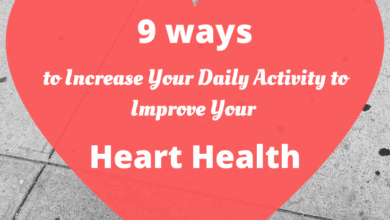
How 12 weeks of stretching can improve your heart health? This isn’t just about flexibility; it’s about a powerful connection between gentle movement and a healthier heart. We’ll explore the science behind how stretching can enhance heart rate variability, blood pressure, and overall cardiovascular function. Get ready to learn how incorporating a simple, 12-week stretching program into your routine can lead to significant improvements in your heart health.
This comprehensive guide delves into the specifics of a 12-week stretching program, designed to improve cardiovascular metrics like resting heart rate and blood pressure. We’ll explore various stretching techniques, from static to dynamic, and analyze their impact on heart health. Expect detailed weekly schedules, modifications for different fitness levels, and a focus on progressive overload and recovery to maximize your results.
Introduction to Stretching and Heart Health
Stretching, often associated with improved flexibility and muscle function, surprisingly plays a significant role in cardiovascular health. While not a replacement for traditional heart-healthy habits like a balanced diet and regular exercise, incorporating stretching into your routine can positively impact your heart’s overall function. This article explores the link between stretching and heart health, delving into the physiological mechanisms and potential benefits.Regular stretching can contribute to better cardiovascular health by promoting relaxation and reducing stress on the heart.
This, in turn, can influence factors like heart rate variability and blood pressure, both crucial indicators of heart health. Furthermore, the different stretching techniques each have their unique impacts, which we’ll explore in detail.
Physiological Mechanisms
Stretching influences cardiovascular health through various physiological pathways. Improved blood flow throughout the body, including the coronary arteries, is one key aspect. Increased blood flow delivers more oxygen and nutrients to the heart, contributing to its efficiency. Additionally, stretching can contribute to reduced muscle tension, which can lower the workload on the heart. This reduction in stress on the heart’s muscles leads to a decrease in the heart’s rate of contraction, thus impacting heart rate variability and blood pressure positively.
Types of Stretching Techniques
Different stretching techniques can produce varying effects on the cardiovascular system. Understanding these distinctions allows individuals to tailor their stretching routine to best suit their needs. Static stretching involves holding a position for an extended period, while dynamic stretching involves controlled movements. Proprioceptive neuromuscular facilitation (PNF) stretching utilizes contractions and relaxations to increase flexibility.
Comparative Analysis of Stretching Techniques
| Stretching Technique | Potential Benefits for Heart Health | Potential Risks |
|---|---|---|
| Static Stretching | Reduces muscle tension, improves blood flow, potentially lowers blood pressure. | May lead to muscle soreness if not performed correctly or held for too long. Less effective for immediate improvements in blood flow compared to dynamic stretching. |
| Dynamic Stretching | Increases blood flow, improves blood pressure, can reduce stress on the heart. Good for warming up and preparing the body for activity. | May be more challenging for beginners. Improper technique can lead to injury. |
| PNF Stretching | Potentially enhances flexibility and blood flow more than other techniques. Can be particularly beneficial for those with limited mobility. | Can be more demanding on the body. Proper instruction is essential to avoid injury. |
The optimal stretching technique for heart health depends on individual needs and preferences. A combination of techniques might yield the best results.
Impact on Heart Rate Variability and Blood Pressure
Regular stretching can positively influence heart rate variability (HRV), a measure of the heart’s natural rhythm fluctuations. Higher HRV generally indicates a healthier cardiovascular system. Stretching can also potentially contribute to lower blood pressure by reducing stress on the cardiovascular system.
Twelve Weeks of Stretching Program Design
Embarking on a stretching journey can be incredibly rewarding, fostering both physical and mental well-being. This structured 12-week program is designed to progressively improve flexibility, strength, and overall heart health, accommodating various fitness levels. It prioritizes safety, gradual progression, and the integration of rest and recovery, crucial elements for maximizing results and preventing injuries.
Program Overview
This program meticulously guides you through a 12-week journey of stretching, focusing on specific muscle groups each week. It emphasizes progressive overload, a key principle in strength training, which can also be applied to stretching. This principle involves gradually increasing the intensity, duration, or frequency of stretches over time. Understanding and applying this principle is essential for achieving optimal results without risking injury.
Weekly Schedule
The program’s weekly structure ensures targeted stretching for different muscle groups. It’s crucial to listen to your body and avoid pushing yourself too hard, especially in the initial weeks. Proper warm-up before each session is vital for injury prevention.
- Week 1-4: Focus on foundational stretches targeting major muscle groups like hamstrings, quads, calves, chest, back, and shoulders. Hold each stretch for 20-30 seconds, repeating each stretch 2-3 times. Aim for 3 stretching sessions per week, gradually increasing to 4 as your flexibility improves.
- Week 5-8: Introduce dynamic stretches, incorporating arm circles, leg swings, and torso twists. Increase the duration of static stretches to 30-45 seconds, maintaining the 2-3 repetitions per stretch. Maintain 3-4 stretching sessions per week.
- Week 9-12: Incorporate advanced stretches and holds, emphasizing deep stretches for improved flexibility. Aim for 45-60 seconds hold times, repeating each stretch 2-3 times. Maintain 3-4 stretching sessions per week.
Progressive Overload in Stretching
Progressive overload in stretching isn’t just about increasing the duration or intensity of a stretch. It also involves gradually increasing the range of motion you’re achieving in each stretch. This gradual increase in the range of motion is crucial to prevent injuries and ensure that your body adapts safely and effectively to the new demands. For instance, you might initially only be able to reach a certain point in a hamstring stretch, but with progressive overload, you’ll gradually be able to stretch further, achieving a deeper stretch and increasing flexibility.
Rest and Recovery
Adequate rest and recovery are essential components of any stretching program. Your body needs time to adapt and repair after each session. Rest days are crucial for preventing injuries and optimizing results. Listen to your body, and don’t hesitate to adjust the intensity or frequency of your stretching sessions if needed.
- Incorporate rest days between stretching sessions. Avoid overstretching, especially in the initial weeks. Listen to your body’s signals.
- Ensure sufficient sleep for optimal muscle recovery.
- Prioritize nutrition to support muscle repair and growth.
Modifications for Specific Needs
This program can be modified to accommodate individuals with pre-existing health conditions or injuries. Consult with a healthcare professional or physical therapist to determine appropriate modifications for your specific needs. Adjusting the duration, intensity, and types of stretches is essential to avoid exacerbating existing conditions or injuries.
- Pre-existing conditions: Modify the program based on the specific condition. Consult a healthcare professional for personalized guidance.
- Injuries: Avoid stretches that exacerbate pain. Focus on stretches that support healing and recovery.
- Physical limitations: Adjust the intensity, duration, and types of stretches as needed. Prioritize safety and avoid pushing through pain.
Weekly Stretching Goals and Progress Tracking
| Week | Stretching Goals | Progress Tracking Metrics |
|---|---|---|
| 1-4 | Master basic stretches for major muscle groups | Record the range of motion achieved in each stretch. Note any discomfort or pain. |
| 5-8 | Increase stretch duration and incorporate dynamic stretches | Track the increase in range of motion and the improvement in flexibility. Note any improvements in mobility. |
| 9-12 | Enhance flexibility with advanced stretches | Assess overall flexibility and mobility. Note any limitations and adjust accordingly. |
Impact on Specific Cardiovascular Metrics: How 12 Weeks Of Stretching Can Improve Your Heart Health
Stretching, often perceived as a complementary activity, can surprisingly contribute to improved cardiovascular health. While vigorous exercise is often associated with heart health benefits, the consistent practice of stretching can yield positive results in specific cardiovascular metrics, particularly over a sustained period like 12 weeks. This section explores the potential impact of a dedicated stretching program on your heart’s performance.
Potential Impact on Resting Heart Rate
A consistent stretching routine can potentially lead to a lower resting heart rate. Regular stretching can improve the flexibility and efficiency of blood vessels, enabling more efficient blood flow throughout the body. This improved circulation can allow the heart to pump blood with less effort, leading to a lower resting heart rate. For example, individuals who regularly engage in stretching routines may experience a decrease in their resting heart rate over time.
Potential Impact on Blood Pressure Readings
Stretching can potentially contribute to improved blood pressure readings. By improving blood vessel elasticity and reducing muscle tension, stretching may facilitate better blood flow. This, in turn, can help maintain healthy blood pressure levels. For example, individuals with mildly elevated blood pressure may experience a slight decrease in their systolic and diastolic readings after 12 weeks of regular stretching.
Impact on Blood Flow Throughout the Body
Stretching plays a crucial role in enhancing blood flow throughout the body. By increasing the flexibility of muscles and blood vessels, stretching can reduce resistance to blood flow. This improved circulation can nourish tissues and organs more effectively. Improved blood flow benefits the entire body, including the heart.
Potential Effects on Measures of Cardiac Output, How 12 weeks of stretching can improve your heart health
Stretching may indirectly affect cardiac output, a measure of the amount of blood the heart pumps per minute. While stretching itself doesn’t directly increase the heart’s pumping capacity, the improved blood vessel function and reduced resistance to blood flow can lead to an increase in cardiac output over time. As a result of enhanced blood vessel elasticity and reduced stress on the cardiovascular system, cardiac output can be influenced positively.
Comparison of Stretching with Other Forms of Exercise
While stretching and other forms of exercise contribute to cardiovascular health, they differ in their primary mechanisms. Cardiovascular exercises like running or cycling directly challenge the heart, leading to a more immediate and pronounced improvement in cardiac output and blood pressure. Stretching, on the other hand, focuses on improving blood vessel function and flexibility, indirectly contributing to cardiovascular health.
The benefits of stretching are more subtle and sustained compared to the immediate effects of cardio.
Potential Changes in Cardiovascular Metrics After 12 Weeks of Stretching
| Cardiovascular Metric | Potential Change After 12 Weeks of Stretching |
|---|---|
| Resting Heart Rate | Possible decrease (e.g., 5-10 bpm) |
| Systolic Blood Pressure | Possible slight decrease (e.g., 5-10 mmHg) |
| Diastolic Blood Pressure | Possible slight decrease (e.g., 2-5 mmHg) |
| Blood Flow | Improved circulation and reduced resistance |
| Cardiac Output | Potential for slight increase due to improved blood flow |
Potential Benefits and Considerations

Stretching, when incorporated into a holistic heart health routine, offers a multitude of potential benefits beyond just improved flexibility. It can positively impact various aspects of well-being, including stress reduction, sleep quality, and mood. Understanding these benefits, along with potential risks and considerations, is crucial for tailoring a safe and effective stretching program.Stretching can be a powerful tool for managing stress.
The gentle movements and focused attention on the body can help calm the nervous system, reducing feelings of anxiety and tension. This relaxation response can have a ripple effect on overall well-being, promoting a sense of calm and balance.
Stress Reduction and Overall Well-being
Stretching can be a valuable component of stress management. Gentle, controlled movements and mindful breathing during stretching can help calm the nervous system, reducing feelings of anxiety and tension. This relaxation response can positively impact overall well-being, promoting a sense of calm and balance. Regular stretching can help to regulate the body’s stress response, leading to reduced cortisol levels, which are associated with chronic stress.
Regular stretching for 12 weeks can seriously boost your heart health, improving blood flow and reducing stress. While focusing on physical well-being, consider a helpful tool like the migraine app helps people with migraines , which can manage symptoms effectively. This holistic approach to better health, incorporating both physical and mental aspects, is key to overall well-being, and consistent stretching plays a significant role in that process.
Potential Benefits for Sleep Quality and Mood
Stretching can significantly impact sleep quality. By releasing tension in muscles, stretching can contribute to a more relaxed state, making it easier to fall asleep and experience more restful sleep. The physical activity and relaxation response induced by stretching can also have a positive effect on mood, potentially reducing feelings of anxiety and depression. Studies have shown that regular stretching can lead to improved sleep patterns and reduced symptoms of insomnia.
Potential Contraindications for Stretching, Especially in Relation to Heart Health
While stretching is generally safe, certain individuals may need to exercise caution. Pre-existing heart conditions, such as uncontrolled high blood pressure or arrhythmias, should be considered. Always consult with a doctor before starting any new exercise program, especially if you have a history of heart problems. Listen carefully to your body and stop if you experience any unusual symptoms, such as chest pain, shortness of breath, or dizziness.
Regular stretching for 12 weeks can significantly boost your cardiovascular health by improving blood flow and flexibility. This increased mobility is crucial for a healthy heart, and incorporating a fitness tracker like a Fitbit can really help you monitor your progress. Want to learn more about using a Fitbit specifically for managing diabetes? Check out our comprehensive guide on all about the fitbit with diabetes.
Ultimately, consistent stretching, alongside smart device usage, will pave the way for a healthier heart over time.
- Uncontrolled high blood pressure: Stretching can temporarily increase blood pressure. If you have uncontrolled hypertension, it’s crucial to consult a doctor before adding stretching to your routine. A gradual introduction and careful monitoring are essential to avoid potential risks.
- Recent heart attack or stroke: Individuals who have recently experienced a heart attack or stroke should avoid strenuous stretching and instead focus on gentle movements. Seek medical advice before initiating any new exercise regimen.
- Arthritis or other joint problems: Stretching should be approached with caution if you have arthritis or other joint conditions. Gentle, controlled movements are important to avoid exacerbating pain or causing further injury.
- Pregnancy: Consult with a doctor or certified prenatal fitness professional before incorporating stretching into your routine during pregnancy. Adjust techniques and avoid positions that may put undue strain on the body.
Importance of Proper Form and Technique in Stretching
Maintaining proper form and technique during stretching is crucial to prevent injuries. Rushing through stretches or using improper form can strain muscles and lead to discomfort or injury. Concentrate on slow, controlled movements and avoid bouncing or jerking. Focus on holding each stretch for an appropriate duration (typically 15-30 seconds) and repeat each stretch 2-4 times.
Examples of How to Listen to Your Body During a Stretching Routine
Pay close attention to your body’s signals. If a stretch causes sharp pain, stop immediately. Discomfort is acceptable, but pain is a signal to modify or discontinue the stretch. Focus on feeling a gentle stretch, not pain. Adjust the stretch as needed to maintain comfort.
Listen to your body’s feedback and adjust your routine accordingly. Gradually increase the intensity and duration of your stretches over time.
Comparing Stretching to Other Heart-Health Improvement Strategies
| Characteristic | Stretching | Aerobic Exercise (e.g., Running) |
|---|---|---|
| Primary Benefit | Improved flexibility, reduced muscle tension, stress relief | Improved cardiovascular function, increased endurance |
| Impact on Heart Rate | Generally minimal increase in heart rate | Significant increase in heart rate |
| Energy Expenditure | Low to moderate | Moderate to high |
| Equipment Needed | Minimal or none | Potentially running shoes, equipment for specific activities |
| Time Commitment | Relatively low | Variable, depending on the intensity and duration of activity |
Illustrative Examples of Stretching Routines
Embarking on a 12-week stretching journey for heart health requires a structured approach. This section provides practical examples of stretching routines tailored to various muscle groups, along with guidance on proper execution, modification, and integration into your daily life. These routines aim to improve flexibility, reduce muscle tension, and enhance overall cardiovascular health.Understanding how specific stretches target different muscle groups is crucial for maximizing the benefits of your routine.
By focusing on major muscle groups, you can optimize blood flow and reduce the risk of stiffness and injury.
Warm-up Exercises
A proper warm-up is essential before any stretching routine. Light cardio, such as brisk walking or jumping jacks, for 5-10 minutes prepares your muscles for the stretching exercises. This increases blood flow, raises body temperature, and reduces the risk of injury.
Lower Body Stretches
- Hamstring Stretch: Gently bend one knee, keeping the other leg straight behind you. Reach for your toes or the top of your foot, keeping your back straight. Hold for 20-30 seconds. Visualize your back as a straight line, and your hips square to the floor. Repeat on the other side.
This stretch targets the hamstrings, improving flexibility and preventing tightness.
- Quadriceps Stretch: Grab your ankle and pull it towards your glutes, keeping your knee aligned with your hip. Hold for 20-30 seconds. Ensure you’re feeling the stretch in the front of your thigh. Repeat on the other side. This stretch focuses on the quadriceps, improving hip flexibility.
- Calf Stretch (Wall): Place your hands on a wall, step one leg back, and keep your front knee aligned over your ankle. Lean into the wall, feeling the stretch in your calf muscle. Hold for 20-30 seconds. Repeat on the other side. This stretch targets the calf muscles, enhancing ankle flexibility and reducing tension.
Upper Body Stretches
- Shoulder Stretch (Cross-Body): Extend one arm across your body and use your other hand to gently press your elbow towards your chest. Hold for 20-30 seconds. Repeat on the other side. This targets the shoulder muscles, improving mobility and reducing tension in the shoulder joint.
- Triceps Stretch: Extend one arm overhead, bending your elbow, and gently pull your elbow back with your opposite hand. Hold for 20-30 seconds. Repeat on the other side. This stretch focuses on the triceps, relieving tension and improving flexibility.
- Chest Stretch (Wall): Place your hands on a wall at shoulder height, step forward, and keep your arms straight. Lean into the wall, feeling the stretch in your chest muscles. Hold for 20-30 seconds. This stretch targets the chest muscles, improving posture and promoting openness in the chest cavity.
Table of Stretches
| Stretch | Target Muscles | Benefits |
|---|---|---|
| Hamstring Stretch | Hamstrings | Improved flexibility, reduced tightness |
| Quadriceps Stretch | Quadriceps | Improved hip flexibility, reduced tension |
| Calf Stretch | Calves | Enhanced ankle flexibility, reduced tension |
| Shoulder Stretch | Shoulders | Improved mobility, reduced tension |
| Triceps Stretch | Triceps | Relieves tension, improves flexibility |
| Chest Stretch | Chest | Improved posture, openness in chest cavity |
Modifying Stretches for Different Fitness Levels
For beginners, start with shorter hold times (15-20 seconds) and gradually increase the duration as you progress. Modify the stretch by adjusting the angle or distance. For example, in the hamstring stretch, you can bend your knees slightly to lessen the stretch if you’re new to it. Consult with a healthcare professional for any specific modifications.
Regular stretching for 12 weeks can significantly boost your cardiovascular health, improving blood flow and reducing stress on your heart. While we’re on the topic of wellness, did you know that the FDA recently approved a new under-eye filler? fda approves new under eye filler how it works This innovative approach to cosmetic enhancements is interesting, but consistent stretching continues to be a powerful tool for a healthier heart, both inside and out.
By incorporating stretching into your routine, you can cultivate a healthier, more vibrant lifestyle.
Incorporating Stretching into Daily Life
Integrate stretching into your daily routine for maximum benefits. Aim for at least 15-20 minutes of stretching daily.
Perform a 5-minute warm-up before and after workouts to improve flexibility, and reduce the risk of injury. Incorporate short stretching sessions into your workday, such as stretching your legs every hour or taking breaks for shoulder stretches.
Structuring a Stretching Session
Begin with a 5-minute warm-up, followed by 10-15 minutes of targeted stretches for different muscle groups. End with a cool-down period of 5 minutes, allowing your body to gradually return to its resting state.
Considerations for Different Populations
While a 12-week stretching program can offer significant cardiovascular benefits for most individuals, tailoring the approach is crucial for various populations. Understanding the unique needs of seniors, those with existing heart conditions, pregnant women, individuals with mobility limitations, and those experiencing chronic pain is vital for maximizing safety and effectiveness. Adapting the program ensures the benefits of stretching are realized without putting participants at risk.
Senior Considerations
Seniors often have decreased flexibility, strength, and balance, making certain stretches more challenging or potentially harmful. Modifications are essential to prevent falls and injuries. The program should emphasize low-impact stretches, held for shorter durations, and focus on maintaining a consistent, comfortable pace. Warm-up periods should be longer, and stretches should be performed in a safe environment, possibly with assistance from a caregiver or physical therapist.
- Reduce the intensity and duration of each stretch, starting with shorter durations and gradually increasing over time.
- Incorporate chair-based stretches to reduce the risk of falls.
- Ensure adequate support, like a chair or wall, for balance during stretches.
- Prioritize stretches that target areas prone to stiffness, such as hips, ankles, and shoulders.
Considerations for Individuals with Existing Heart Conditions
Individuals with existing heart conditions should consult their physician before starting any new exercise program, including stretching. The program should be designed to minimize stress on the cardiovascular system and prevent any strain or discomfort. Stretching should be performed slowly and gradually, and the intensity should be monitored closely. Heart rate should be closely monitored during and after each session.
Modifications to the program should prioritize low-impact stretches, short duration, and gradual intensity increases.
- Always consult a doctor or cardiologist before starting any new exercise program, including stretching.
- Start with shorter stretching sessions and gradually increase the duration.
- Monitor heart rate closely during and after stretching.
- Choose stretches that do not involve holding the breath.
Considerations for Pregnant Women
Pregnancy brings unique physical changes and considerations for stretching. Stretches should focus on maintaining flexibility and supporting the changing posture and structure of the body. Avoid stretches that put pressure on the abdomen or may strain the lower back. Stretches should be modified to accommodate the growing belly and changing center of gravity. The focus should be on gentle, controlled movements.
- Avoid stretches that put pressure on the abdomen or may strain the lower back.
- Modify stretches to accommodate the growing belly and changing center of gravity.
- Always listen to your body and stop if you experience any discomfort.
- Focus on gentle, controlled movements.
Modifications for Individuals with Mobility Limitations
Individuals with mobility limitations may require adjustments to the stretching program. Assistive devices such as chairs, walls, or resistance bands can be helpful to support movements and maintain proper form. Stretches should be modified to accommodate limitations and focus on improving flexibility in accessible ranges of motion.
- Use assistive devices like chairs, walls, or resistance bands to support movements.
- Modify stretches to accommodate limitations, focusing on accessible ranges of motion.
- Incorporate stretches that can be performed while seated or standing near a stable surface.
- Focus on stretching areas that are most affected by mobility limitations.
Considerations for Individuals with Chronic Pain Conditions
For individuals with chronic pain conditions, stretching should be approached cautiously and with the guidance of a physical therapist or healthcare professional. Stretching should be aimed at improving flexibility and reducing pain, not exacerbating it. Stretches should be held for shorter durations and performed at a slower pace. Focus on stretches that target the specific areas causing pain.
- Consult with a physical therapist or healthcare professional for personalized guidance.
- Perform stretches slowly and gradually, and avoid any movements that cause sharp or increased pain.
- Focus on stretches that target the specific areas causing pain.
- Listen to your body and stop if you experience any discomfort or pain.
Summary Table
| Population | Key Considerations |
|---|---|
| Seniors | Low-impact stretches, shorter durations, support for balance, chair-based options |
| Existing Heart Conditions | Consult physician, slow gradual progression, monitor heart rate, low-impact stretches |
| Pregnant Women | Avoid abdominal pressure, modify for changing posture, listen to body |
| Mobility Limitations | Assistive devices, focus on accessible ranges of motion, seated/supported stretches |
| Chronic Pain | Cautious approach, physical therapist guidance, pain-free movements, shorter durations |
Closure

In conclusion, incorporating a well-structured 12-week stretching program can be a valuable addition to your heart health routine. By understanding the science behind stretching’s impact on cardiovascular metrics and implementing a personalized program, you can achieve significant improvements. Remember, consistency and proper form are key to experiencing the full benefits. So, are you ready to stretch your way to a healthier heart?





